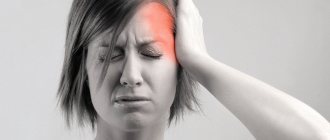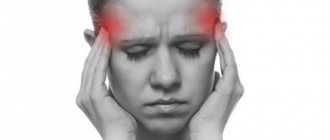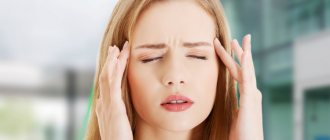We live in a constant abyss of worries: heaps at work, bills for housing and communal services, an atrocious boss and early rises. All this fuss affects the human nervous system and causes headaches. However, not only a busy schedule can cause its appearance; there are many other explanations for this illness.
It is very rare to meet a person who has not experienced a headache. This complaint is one of the most common, according to doctors. And more than 13% of the population of our planet suffers from chronic headaches.
What if your head hurts in your temples?
Temporal headache is the most common type of headache.
Experts attribute the following to the primary reasons:
- neuralgia
- cluster pain
- overvoltage
- migraine
Secondary causes include:
- cerebral vascular damage
- taking medications
- head or neck injury
- non-vascular intracranial lesions
- HIV infection and AIDS
- hemostasis disorder
- pathology of the skull
- psychological illnesses
What to do if you have a headache in your temples? – If this happens for the first time, then you need to take an analgesic. If the pain persists after taking painkillers, you should consult a specialist. If you experience intense and frequently recurring pain in your temples, it is better to consult a therapist or neurologist. If the pain is a consequence of an injury, then you should make an appointment with a surgeon or traumatologist.
What if you have a headache in the back of your head?
Usually such a severe headache chills a person and prevents him from functioning normally. This is a very serious inflammation that you should not experience on your own without medical help. Usually the back of the head hurts due to pathologies. It is better not to try to relieve the disease with analgesics, but to immediately consult a doctor.
Headache in the back of the head can be a signal of diseases:
- nervous system
- vessels
- spine.
Causes of headaches in the back of the head:
- Tension headache. Usually discomfort is associated with tension in the neck muscles. They compress the arteries and nerves that carry blood and impulses to the brain, which is accompanied by a pain reaction in the back of the neck and in the back of the head. In some cases, the provoking factor is emotional tension and stress, which leads to spasm of the neck muscles.
- Migraine is an acute and painful attack of unilateral and occipital headache. An attack can last for several hours or several days. The cause of the disease can be physical activity, overexertion and changes in weather conditions. Most often, women suffer from migraines, and the average age of those affected is from 25 to 35 years.
- Osteochondrosis of the cervical spine is a chronic progressive disease that thins the cartilage in the neck. It can occur after a neck injury, vertebral displacement, sedentary lifestyle or excess weight. The disease can also cause pain in the back of the head.
- Sudden pressure surges.
- Occipital neuralgia provokes an acute headache. Discomfort begins in the occipital region, but can spread to the frontal and temporal lobes. This condition can occur after a neck injury, arthritis, or muscle spasms.
- Use of medications. In self-medication, people “prescribe” themselves medications to treat migraines. This initiative provokes a medicinal headache. It occurs as a reaction of the body to frequent intake of active substances of analgesics.
Harmful daily habits for humans
At times, the answer to the question of why the back of the head and neck hurts is the incorrect location of the workspace relative to the eyes. If pain appears at the end of a work shift, this is a direct signal that work is the source of the problem. People do not pay attention to their posture, they lower their heads down, without looking up from, for example, paperwork for several hours.
To avoid heaviness in the back of the head and neck, it is necessary to place the monitor in front of the eyes. It is important to take breaks, warm up as often as your work allows, and do basic head tilts to relax your muscles.
To forget how much your neck and back of your head hurt, it is important to say goodbye to many daily bad habits. For example, many people hold a telephone receiver between their neck and shoulder. Some people are used to sleeping in a chair with their head thrown back and their chin down. Women in the modern rhythm of life are accustomed to doing everything as quickly as possible, but without caring about their health. For example, washing your hair in the sink, or leaning under the tap in the bathroom. This can become a source of pain in the neck and back of the head.
Even waking up, during which the back of your head and neck hurts and you feel dizzy, can be an alarming signal. The culprits of unpleasant sensations are the pillow and mattress. In order to prevent serious illnesses, it is worth changing the mattress to a firm one, and the pillow to one of such a height that the head is at the same level as the spine.
It is obvious that many daily habits can cause significant harm to the body. Changing habits can be easy, which will ultimately lead to healthy functioning of the body.
With tips on actions to relieve heaviness in the neck and back of the head, everyone can put their body in order. Of course, all the methods presented are not a panacea, but an excellent help in solving the problem that has arisen. Doctors should not be neglected: they will be able to tell exactly why the neck and back of the head hurt. It is important to follow these recommendations in combination, because only well-designed therapy will help you say goodbye to the disease that causes discomfort.
Why does my head hurt and feel nauseous?
Among the causes of nausea and headaches are infectious and non-communicable diseases, pathologies of the nervous and cardiovascular systems. The disease manifests itself due to intoxication and insufficient blood supply to the brain. Typically these symptoms indicate severe fatigue and impairment. This type of headache can also occur during pregnancy.
Causes:
- Overwork and lack of sleep. The body does not have time to recover and rest due to lack of sleep, which leads to negative health.
- Viral diseases that affect body systems and organs. Additional symptoms in such cases will be fever, muscle and joint aches.
- Viral diseases can cause headaches and nausea. For example, flu or sore throat, as well as seasonal infection, can trigger the disease. In this case, experts recommend bed rest and drinking plenty of fluids.
- Lyme disease is an infectious disease caused by a tick bite.
- Pregnancy.
Causes
The etiology of the symptom is very diverse. The cause can be many pathophysiological processes in the body. These include:
- Arterial hypertension;
- Hormonal fluctuations: pregnancy, menstruation, menopause, hormonal dysfunction, etc.
- Stress, tension;
- Visual fatigue;
- Consequences of traumatic brain injury, including subdural hematomas;
- Tumor processes, space-occupying formations of the brain;
- Purulent abscesses;
- Intracranial hemorrhage;
- Psychological disorders;
- Encephalitis, meningitis, meningoencephalitis;
- Inflammatory diseases of the middle and inner ear;
- Increased intracranial pressure;
- Neuroses;
- Pathologies of the temporomandibular joint;
- Vascular pathologies;
- Taking certain medications, including analgesics, that can cause abusive headaches;
- Alcohol abuse;
- Hypothermia or heat stroke;
- Osteochondrosis;
- Sinusitis;
- Sinusitis;
- Chronic rhinitis;
- Sleep disorders.
To establish the etiology, the doctor focuses on the nature of the pain, its location, duration, and intensity. Not all of these conditions require drug treatment. Associated factors are of great importance, including:
- Nausea;
- Vomit;
- Tearing;
- Light and noise sensitivity;
- Feeling of colored spots before the eyes;
- Febrile and subfebrile temperature;
- Symptoms of an infectious disease;
- Nosebleeds, etc.
If headaches recur, it is important to identify the frequency of episodes. Determine after what period of time attacks occur. It matters at what age the pathology debuted. The doctor finds out whether the position of the patient’s body and head affects the intensity of pain.
Why does my head hurt in the forehead area?
This phenomenon is quite common in all age groups of the population. Such pain can be acute or chronic, occur independently or in combination with other symptoms. Pain in the frontal lobe occurs even in a healthy person, so their one-time occurrence should not be a cause for concern.
If a person constantly has a headache in the frontal lobes, then there are a number of reasons for this:
- Tension headaches can occur even in healthy people. We must remember that rest is an integral part of the life process. This pain may go away after taking analgesics.
- Eye pain may also spread to the forehead area. The pain begins behind the eyes and spreads to the frontal lobe. Its manifestations are similar to tension headaches: they occur against the background of overwork or active mental work, last from several hours to several days, and are easily relieved with over-the-counter analgesics.
- Sinusitis causes sharp pain in the frontal part of the head and nose. Accompanied by impaired nasal breathing, lacrimation and decreased sense of smell.
- Arteritis is considered the rarest cause of headaches. The disease is associated with inflammation of the walls of large arteries. They become dense and visible above the surface of the skin. The main symptom of the disease is acute pain in the forehead.
Why does my head hurt after sleep?
A morning headache brings discomfort throughout the day. Night sleep is the time when, after a hard day, our body restores strength. But from time to time awakening is overshadowed by unpleasant sensations.
The reason for such an uncomfortable awakening may be:
- Uncomfortable sleeping position.
- Incorrectly chosen pillow or mattress. Ignoring this moment leads to morning pain throughout the body, including the head.
- When the condition of blood vessels deteriorates, blood pressure is disturbed, which affects the quality of our sleep. Then feeling unwell becomes frequent.
- Head injuries can also contribute to headaches in the morning. It can occur a week or a month after the injury.
- Sinusitis makes breathing difficult, which causes a headache when waking up.
- Cervical osteochondrosis is a displacement of the spine in the cervical region. With this disease, the supply of oxygen to the brain is disrupted.
Treatment
Before starting treatment, you must visit a neurologist, ophthalmologist and therapist. In some cases, you need to contact an infectious disease specialist. Since all doctors unanimously insist that headaches should not be tolerated under any circumstances, you need to take one of the following medications:
- Citramon;
- Farmadol;
- No-shpa;
- Aspirin.
Even if a strong pulsation is felt, the dosage of the above medications cannot be exceeded, since the body will not receive any benefit. After taking the tablet, you need to lie down in silence, because any physical activity leads to a significant increase in pain.
After the doctor has found out the cause of the throbbing pain in the left side of the head, right or back of the head, the patient, in addition to treatment, needs to carry out the following procedures to normalize the body’s condition:
- Perform a warming massage in order to warm up the blood vessels and improve the condition of osteochondrosis and neuralgia. In addition to massage, manual therapy will help improve your well-being.
- A soft and gentle massage will alleviate the condition of intracranial hypertension.
- Japanese acupressure will improve your well-being for various types of pain.
- Regularly measuring blood pressure and bringing it back to normal in a timely manner will help eliminate throbbing pain.
- Physiotherapy will be appropriate for osteochondrosis, neuralgia, increased intracranial pressure and various vascular changes.
- Doctors prescribe physical therapy for all types of throbbing pain.
- Surgery is inevitable for tumors and other serious diseases.
As you can see, throbbing pain in the head is a symptom of many diseases. Therefore, you must definitely consult with a specialist or call an ambulance, because home methods can only get rid of mild pain.
Does paracetamol help with headaches?
Paracetamol is an affordable and time-tested medicine for various types of pain. The drug alleviates the physical condition and has almost no side effects. The medicine helps adults and children, but requires careful dosage when used.
Paracetamol mainly acts as a pain reliever. The phenacetin derivative inhibits the production in the body of compounds responsible for sensitivity to pain - prostaglandins. At the same time, it affects the thermoregulation centers, reducing high body temperature.
Paracetamol is good for relieving headaches in acute respiratory infections. In other cases, it is worth using another analgesic or seeking medical help. In some cases, paracetamol will only dull the pain, but not solve the problem completely.










